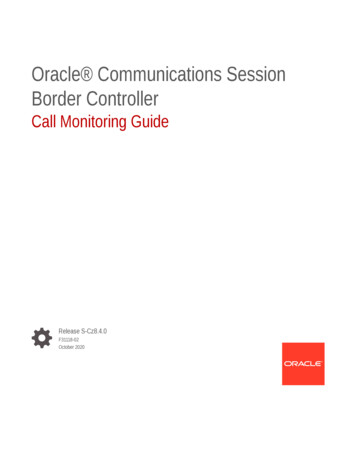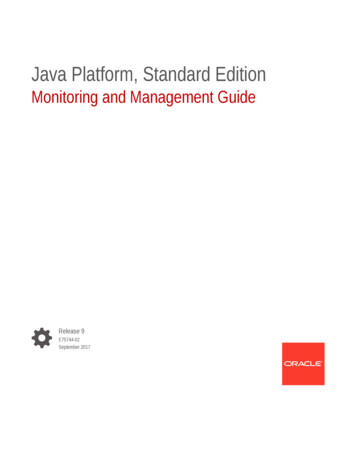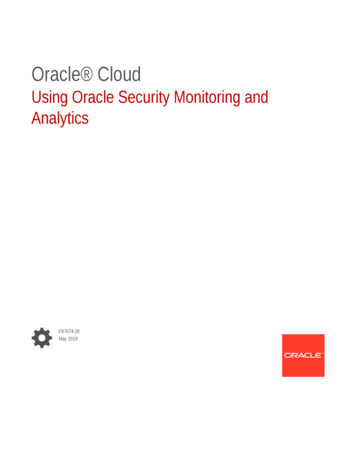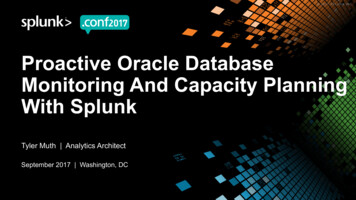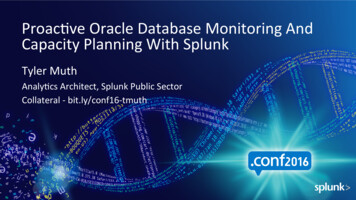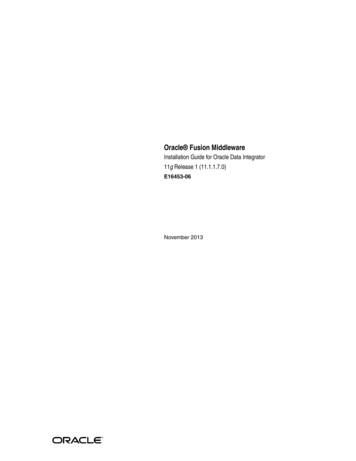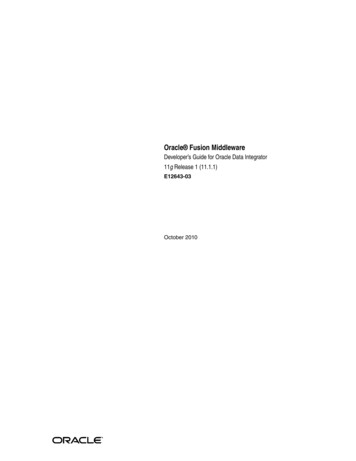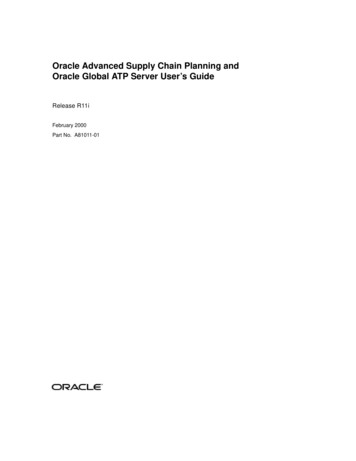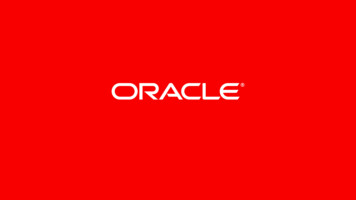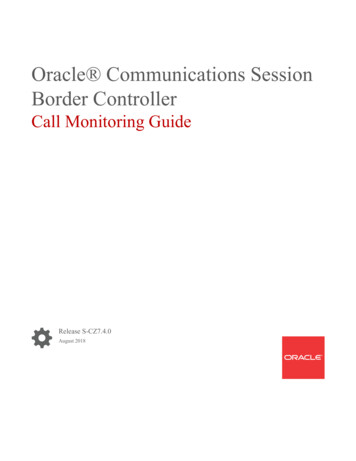
Transcription
Oracle Communications SessionBorder ControllerCall Monitoring GuideRelease S-CZ7.4.0August 2018
Oracle Communications Session Border Controller Call Monitoring Guide, Release S-CZ7.4.0Copyright 2014, 2018, Oracle and/or its affiliates. All rights reserved.This software and related documentation are provided under a license agreement containing restrictions on use anddisclosure and are protected by intellectual property laws. Except as expressly permitted in your license agreement orallowed by law, you may not use, copy, reproduce, translate, broadcast, modify, license, transmit, distribute, exhibit,perform, publish, or display any part, in any form, or by any means. Reverse engineering, disassembly, or decompilationof this software, unless required by law for interoperability, is prohibited.The information contained herein is subject to change without notice and is not warranted to be error-free. If you findany errors, please report them to us in writing.If this is software or related documentation that is delivered to the U.S. Government or anyone licensing it on behalf ofthe U.S. Government, then the following notice is applicable:U.S. GOVERNMENT END USERS: Oracle programs, including any operating system, integrated software, anyprograms installed on the hardware, and/or documentation, delivered to U.S. Government end users are "commercialcomputer software" pursuant to the applicable Federal Acquisition Regulation and agency-specific supplementalregulations. As such, use, duplication, disclosure, modification, and adaptation of the programs, including any operatingsystem, integrated software, any programs installed on the hardware, and/or documentation, shall be subject to licenseterms and license restrictions applicable to the programs. No other rights are granted to the U.S. Government.This software or hardware is developed for general use in a variety of information management applications. It is notdeveloped or intended for use in any inherently dangerous applications, including applications that may create a risk ofpersonal injury. If you use this software or hardware in dangerous applications, then you shall be responsible to take allappropriate fail-safe, backup, redundancy, and other measures to ensure its safe use. Oracle Corporation and its affiliatesdisclaim any liability for any damages caused by use of this software or hardware in dangerous applications.Oracle and Java are registered trademarks of Oracle and/or its affiliates. Other names may be trademarks of theirrespective owners.Intel and Intel Xeon are trademarks or registered trademarks of Intel Corporation. All SPARC trademarks are used underlicense and are trademarks or registered trademarks of SPARC International, Inc. AMD, Opteron, the AMD logo, andthe AMD Opteron logo are trademarks or registered trademarks of Advanced Micro Devices. UNIX is a registeredtrademark of The Open Group.This software or hardware and documentation may provide access to or information about content, products, andservices from third parties. Oracle Corporation and its affiliates are not responsible for and expressly disclaim allwarranties of any kind with respect to third-party content, products, and services unless otherwise set forth in anapplicable agreement between you and Oracle. Oracle Corporation and its affiliates will not be responsible for any loss,costs, or damages incurred due to your access to or use of third-party content, products, or services, except as set forth inan applicable agreement between you and Oracle.
ContentsPreface: About this Guide1Call Traffic MonitoringSelectiveCall Recording SIPREC1-1SIPREC Feature1-1Configuring SIPREC1-2Session Recording Server (SRS)1-2Session Recording Group1-3Load Balancing1-3Session Recording Group within Logical Remote Entities1-4Selective Recording1-4High Availability (HA) Support1-5SIPREC Configuration Procedure1-5Session-recording-server Attribute1-5Session-recording-group Attribute (for HA only)1-7Realm-config Attribute1-9Session-agent Attribute1-10Sip-interface Attribute1-11P-Asserted Identity and Diversion Headers in SIPREC Metadata1-12Metadata Contents1-13Show Commands for Recording Sessions1-14Show rec1-14Show rec redundancy1-15Inserting SIP Headers into SIPREC Metadata1-16Sample Metadata1-17Configure SIP Headers for SIPREC Metadata1-18SIPREC Recording Session Refresh1-18Timer B1-19OPTIONS Request/Response1-19Recording Session Refresh Configuration1-19Codec Negotiation1-20SIPREC Call Flows1-21iii
Selective RecordingNormal Call (recording required)1-21Sample SDP and Metadata1-23Normal Call (recording not required)1-24Early Media Call (recording not required)1-25REFER Pass-Through Call (REFER handled by User Agent)1-27REFER Call (REFER handled by Oracle Communications Session BorderController)1-28SRS Indicates Busy in Call (recording not required)1-30Call Transfer Scenario (recording required)1-32Oracle Communications Session Monitor Mediation Engine1-33IPFIX1-34Communications Monitor Configuration1-34Communication Monitor1-34TSCF Rekey Profile Configuration1-36TLS Profile Configuration1-37Oracle Communications Session Monitor Statistics1-38Packet Trace1-40Packet Trace Remote1-40Packet Trace Local1-42Packet Trace Scenarios1-42Packet Trace for One Endpoint1-42Packet Trace for Both Call Legs1-43Packet Trace for a Oracle Communications Session Border Controller SignalingAddress1-44Running Packet Trace21-211-45Configuring a Trace Server1-46Starting a Remote Packet Trace1-46Stopping a Remote Packet Trace1-47Starting a Local Packet Trace1-47Stopping a Local Packet Trace1-48Web-based GUIIntroduction2-1Web Browser Support2-1Overview2-1Logging in2-1About Information2-3Customizing the Page Display2-4Changing Number of Data Items on the Page2-5Navigating Pages2-6iv
Refresh2-6Pop-up Context Menu2-7Help Menu2-7Tool-Tip HelpSearch for a RecordExporting Information to a Text FileSession Reports2-92-92-142-15Session Report Configuration2-17Ladder Diagram2-17Session Summary2-19SIP Message Details2-20QoS Statistics2-21Registration Reports2-22Subscription Reports2-24Notable Event Reports2-26v
Preface: About this GuidePreface: About this GuideThe Oracle Communications Session Border Controller Call Traffic Monitoring Guide providesinformation about monitoring the call traffic on your system.Related DocumentationThe following table lists the members that comprise the documentation set for this release.Document NameDocument DescriptionAcme Packet 4500 Hardware InstallationGuideContains information about the components andinstallation of the Acme Packet 4500.Acme Packet 3820 Hardware InstallationGuideContains information about the components andinstallation of the Acme Packet 3820.Acme Packet 4600 Hardware InstallationGuideContains information about the components andinstallation of the Acme Packet 4600.Acme Packet 6100 Hardware InstallationGuideContains information about the components andinstallation of the Acme Packet 6100.Acme Packet 6300 Hardware InstallationGuideContains information about the components andinstallation of the Acme Packet 6300.Release NotesContains information about the current documentation setrelease, including new features and management changes.ACLI Configuration GuideContains information about the administration andsoftware configuration of the Service Provider OracleCommunications Session Border Controller.ACLI Reference GuideContains explanations of how to use the ACLI, as analphabetical listings and descriptions of all ACLIcommands and configuration parameters.Maintenance and Troubleshooting GuideContains information about Oracle CommunicationsSession Border Controller logs, performanceannouncements, system management, inventorymanagement, upgrades, working with configurations, andmanaging backups and archives.MIB Reference GuideContains information about Management Information Base(MIBs), Oracle Communication's enterprise MIBs, generaltrap information, including specific details about standardtraps and enterprise traps, Simple Network ManagementProtocol (SNMP) GET query information (includingstandard and enterprise SNMP GET query names, objectidentifier names and numbers, and descriptions), examplesof scalar and table objects.Accounting GuideContains information about the Oracle CommunicationsSession Border Controller’s accounting support, includingdetails about RADIUS and Diameter accounting.HDR Resource GuideContains information about the Oracle CommunicationsSession Border Controller’s Historical Data Recording(HDR) feature. This guide includes HDR configurationand system-wide statistical information.vi
Preface: About this GuideDocument NameDocument DescriptionAdministrative Security EssentialsContains information about the Oracle CommunicationsSession Border Controller’s support for its AdministrativeSecurity license.Security GuideContains information about security considerations andbest practices from a network and application securityperspective for the Oracle Communications SessionBorder Controller family of products.Installation and Platform Preparation Guide Contains information about upgrading system images andany pre-boot system provisioning.Call Traffic Monitoring GuideContains information about traffic monitoring and packettraces as collected on the system. This guide also includesWebGUI configuration used for the SIP Monitor and Traceapplication.Revision HistoryDateDescriptionNovember 2016 Initial ReleaseFebruary 2017 Updates Egress RTP packet captureinformation under Packet TraceClarifies that local packet capture does notinclude RTP January 2018 Removes deprecated Web ServerConfiguration chapter.August. 2018 Adds statement that running packet trace on astandby node is not supportedAdds external pointers directing users to packtrace syntax standards vii
1Call Traffic MonitoringSelectiveCall Recording SIPRECThe SIPREC protocol is the protocol used to interact between a Session Recording Client(SRC) (the role performed by Oracle Communications Session Border Controller) and aSession Recording Server (SRS) (a 3rd party call recorder or Oracle CommunicationsInteractive Session Recorder’s Record and Store Server (RSS)). It controls the recording ofmedia transmitted in the context of a communications session (CS) between multiple useragents.SIPREC provides a selective-based call recording solution that increases media and signalingperformance on 3rd party call recording servers, more robust failovers, and the ability toselectively record.Note:SIPREC isolates the 3rd party recorders from the communication session. The 3rd partyrecorders can determine whether or not recording is desired.Note:The SRC starts a recording session for every call within a configured realm. All callfiltering, if desired, must be accomplished by the SRS. The SRS performs the filteringand selection of which sessions it should record.SIPREC FeatureThe SIPREC feature supports active recording, where the Oracle Communications SessionBorder Controller acting as the SRC, purposefully streams media to the OracleCommunications Interactive Session Recorder’s RSS (or 3rd party call recorder) acting as theSRS. The SRC and SRS act as SIP User Agents (UAs). The SRC provides additionalinformation to the SRS to describe the communication sessions, participants and media streamsfor the recording session to facilitate archival and retrieval of the recorded information.The Oracle Communications Session Border Controller acting as the SRC, is the source for therecorded media. The Oracle Communications Session Border Controller consumesconfiguration information describing the ecosystem within which it operates. The interface,realm and session agent configuration objects specify the SIPREC configuration. A SIP UA canelect to allow or disallow any network element from recording its media.During the establishment of a SIP Session, the Oracle Communications Session BorderController determines if SIPREC is configured for recording the call. If so, it then duplicatesthe media prior to initiating the session with the SRS. (Media replication is set up prior to the1-1
Chapter 1Configuring SIPRECrecording session). The SRS may choose to record, not record, or cancel the recording session,and then communicates via SIP signaling to the Oracle Communications Session BorderController. If the call is not to be recorded, the SRS signals termination of the recordingsession.The Oracle Communications Session Border Controller maintains SIPREC metadatainformation associated with recording sessions. The recording session metadata describes thecurrent state of the recording session and its communication session(s). It is updated when achange of state in the communication session(s) is observed by the Oracle CommunicationsSession Border Controller. The SRS is responsible for maintaining call history, etc. The OracleCommunications Session Border Controller creates and logs call detail records (CDRs) in thecurrent manner, the 3rd party SRS vendor may collate this information if desired. (For moreinformation about the contents of metadata, see Metadata Contents).The following illustration shows two endpoints, User Agent A (UA-A) and User Agent B (UAB). Their session is being recorded by an SRC (the Oracle Communications Session BorderController) and an SRS.Configuring SIPRECThis section defines the information required to configure SIPREC on the OracleCommunications Session Border Controller. It also provides a sample procedure forconfiguring SIPREC using the Acme Packet Command Line Interface (ACLI).Session Recording Server (SRS)The Oracle Communications Interactive Session Recorder’s RSS acts as the SRS in thenetwork. A session-recording-server attribute under the session-router object in the OracleCommunications Session Border Controller ACLI allows you to enable/disable the SRS. Thisobject is the session recording server that receives replicated media and records signaling.Additional parameters for SRS are configured under the session-agent, realm-config, and sipinterface objects. The rules of precedence for which the Oracle Communications SessionBorder Controller uses these parameters are:session-agent takes precedence over the realm-config, and realm-config takes precedenceover sip-interface.1-2
Chapter 1Configuring SIPRECEach SRS is associated with a realm-config. The realm specifies the source interface fromwhich replicated traffic originates. The destination is an IP Port parameter (IP address orhostname with an optional port) that defines the SIP address (request URI) of the actual SRS.For an additional level of security, Oracle recommends the SRS be configured in its own realmso as to apply a set of access control lists (ACLs) and security for the replicatedcommunication.Although the Oracle Communications Session Border Controller supports large UDP packets,Oracle recommends the sip-interface associated with the SRS realm, be provisioned with aTCP port.Session Recording GroupThe Oracle Communications Session Border Controller uses the session-recording-groupattribute under the session-router object in the ACLI to set high availability (HA) for 3rd partycall recorders. Using this object, you can define a collection of one or more SRSs. The OracleCommunications Session Border Controller utilizes SIP’s transport mechanism and keeps trackof statistics on each SRS to manage the distribution of traffic and load balancing. (For moreinformation on Oracle Communications Session Border Controller load balancing in sessionrecording groups, see Load Balancing). When multiple SRSs are in a session recording group,the Oracle Communications Session Border Controller uses heuristics to intelligently route therecording dialog to one or more SRSs utilizing the selection strategy.The simultaneous-recording-servers configuration attribute controls the number ofsimultaneous SIP dialogs that the Oracle Communications Session Border Controllerestablishes to the SRSs in the session recording group per communication session. For instance,if a session recording group contains 3 SRSs, and simultaneous-recording-servers is set to 2,the recording agent initiates a SIP INVITE to the next two SRSs based on the session recordinggroup strategy. In this way, duplicative recording sessions are instantiated, allowing forrecording redundancy in multiple SRSs or within a session recording group.Note:The Oracle Communications Session Border Controller streams media to all SRSs.Each SRS chooses whether or not to ignore the media by returning a recvonly(receiveonly) media line. This permits an SRS to select specific media to record in therecording session, as well as determine whether or not to record the media.The number of simultaneous recording servers does not dictate the number of recording devicesrequired to be active for a communication session. If two SRSs exist in a session recordinggroup and simultaneous-recording-servers is set to 2, if at least one recording device to anyof the servers completes, the recording server is treated as being established.Load BalancingThe Oracle Communications Session Border Controller supports recording server loadbalancing across members of a session recording group using the following strategies:Note:SRS groups support “round-robin” and “hunt” strategies only.1-3
Chapter 1Configuring SIPREC[Round-robin]: The Oracle Communications Session Border Controller remembers the lastSRS that was used. Each new recording session selects the next SRS in the session recordinggroup. When simultaneous-recording-servers is greater than 1, the next n recording servers areselected from the session recording group.[hunt]: The Oracle Communications Session Border Controller successively attempts tocontact SRSs in the session recording group until a successful recording dialog is establishedwith the SRS, starting from the first SRS in the session recording group. The OracleCommunications Session Border Controller attempts to contact each SRS in the sessionreporting group once. When contact is exhausted, the recording device is considered failed. ASIP failure (response greater than 399, timeout or TCP setup failure) causes the OracleCommunications Session Border Controller to attempt the next possible SRS. Whensimultaneous-recording-servers is greater than 1, the Oracle Communications Session BorderController attempts to establish n recording devices in a hunting fashion.Session Recording Group within Logical Remote EntitiesEach logical remote entity (session-agent, realm-config and sip-interface) has a sessionrecording-server attribute.This attribute is a reference to a specific SRS configuration andcan be used to specify a session recording group instead. If a session recording group isspecified instead of an SRS, the session recording group name must be prefixed with "SRG:"followed by the session recording group name. This distinguishes between an SRS beingreferenced and a session recording group being referenced.With SIPREC, if an SRS or session recording group is configured on both the ingress andegress logical remote entities, both the ingress and egress SRS/session recording groups areused. This means that the Oracle Communications Session Border Controller records the mediabetween participants twice (or more) - once for the ingress recorders and once for the egressrecorders.If both the ingress and egress SRS/session recording group are the same, the OracleCommunications Session Border Controller makes an optimization and only records the mediaonce. Even if the ingress session recording group is the same exact set of SRSs as the egresssession recording group (but with a different name), the Oracle Communications SessionBorder Controller replicates media to both destinations. However, if the same set of SRSs hasthe exact same identifier, theOracle Communications Session Border Controller sends media to one and not both SRSs.Selective RecordingSIPREC defines a number of use cases for which the Oracle Communica
Inserting SIP Headers into SIPREC Metadata 1-16 Sample Metadata 1-17 Configure SIP Headers for SIPREC Metadata 1-18 SIPREC Recording Session Refresh 1-18 Timer_B 1-19 OPTIONS Request/Response 1-19 Recording Session Refresh Configurati
